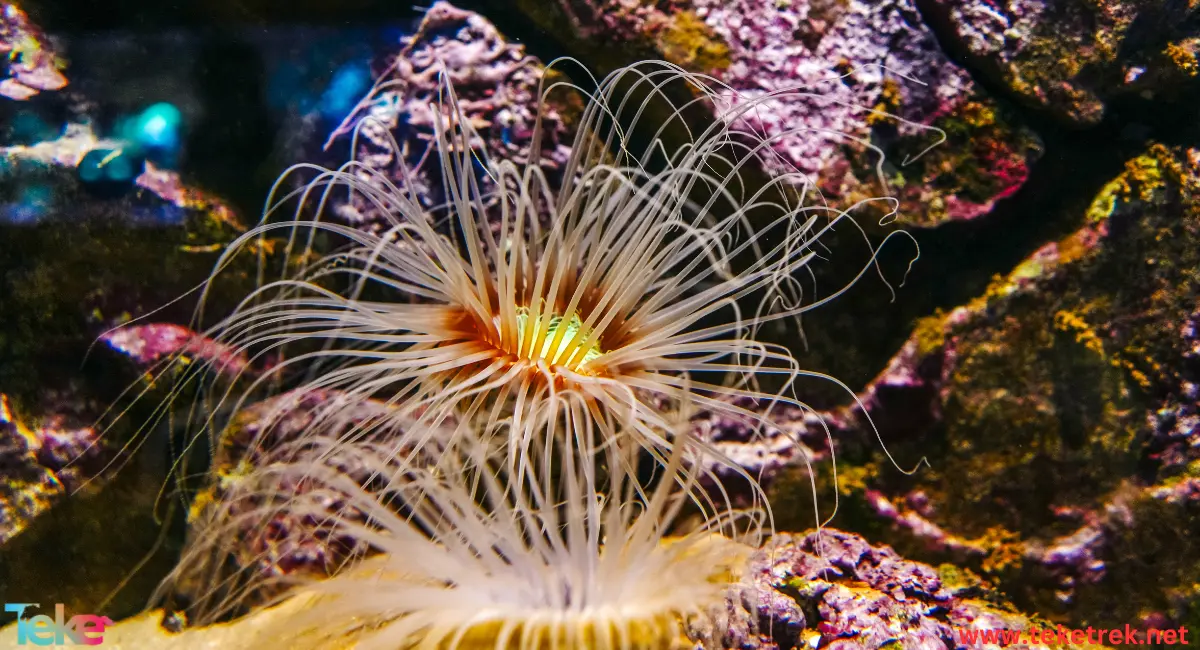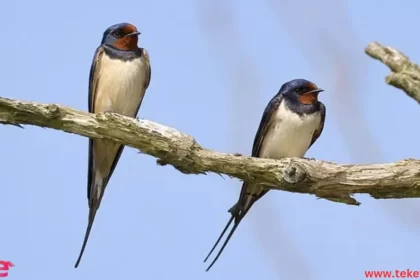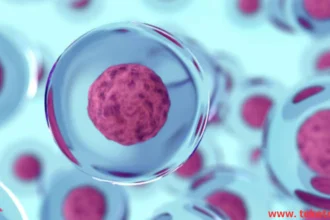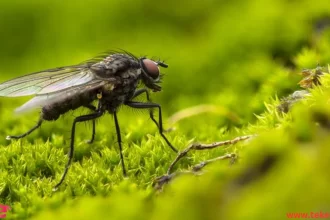Sea anemones are famous for their association with clownfish, but these fascinating animals are more than just a home for another creature. They differ from each other in terms of different shapes and sizes, and each has its own unique characteristics.
In the following, we will talk from teketrek about these strange creatures, their behavior, feeding methods, and reproduction.

Description of sea anemones:
Most sea anemones consist of a base and an oral disc surrounded by tentacles. The base is the leg that connects the animal to surfaces. The oral disc is a copy of the face of sea anemones. It contains a flat surface with a mouth in the middle, and tentacles for catching prey around the edges.
The stinging tentacles of sea anemones provide a means to catch prey, as well as protection from predators. Their tentacles are very similar to those of a jellyfish. The tentacles are lined with stinging cells called “cnidocytes”.
These stinging cells eject small harpoons filled with poison called “nematocysts”.
The poisons found in the thread sac are used to paralyze or kill a sea anemone’s prey.
Interesting facts about sea anemones:
There are over 1000 known species of sea anemones that are bound to survive. Some of it are:
– Giant green anemone.
– Beaded anemones.
– Caecilian anemone.
– Plum clonal anemone.
– Giant carpet anemone.
The types of clownfish and associated anemones are so specialized that they have become obligate mutualists.
This means that each animal benefits greatly from the other, and cannot live without it.
The clownfish removes parasites, maintains the cleanliness of the anemones, and expels fish that try to eat its host.
The anemone provides a predator-resistant home for the clownfish to hide in.
Sea anemones come in almost all colors, starting from shiny blue to red.
Sea anemones can be found at almost any depth in the ocean.
The size of sea anemones ranges from just a few centimeters to six feet wide.
Habitat of sea anemones:
Sea anemones can be found in almost all marine habitats, but the largest number of them are found in tropical regions.
The nutrient-rich tropical seas and ecosystems support the largest diverse group of sea anemones.
Sea anemones can be found almost all over the world.
Some species adapt to life in the cold Arctic waters, but most live in tropical seas near the equator.
Diet of sea anemones:
Most sea anemones are predators.
Sea anemones use the stinging cells in their tentacles to stun and catch their prey.
They often paralyze them with toxins before moving them towards the mouth cavity for digestion.
Common prey types for sea anemones include various crustaceans, such as crabs and shrimp-like organisms.
Many small fish and mollusks like clams also fall victim to predatory sea anemones.
Behavior of sea anemones:
Most sea anemones are sessile, meaning they attach to the surface and remain stationary for long periods.
Any movement made by sea anemones is extremely slow, requiring a time-lapse camera to display.
Sea anemones can hunt prey that is within reach of their stinging tentacles.
After paralyzing it, the prey is pulled into the mouth of the sea anemone.
Sea anemones reproduce by releasing their eggs and sperm into the water column. This often occurs in synchronized spawning events. Once the eggs are fertilized, they develop into a “planula larva,” which remains part of the zooplankton community until it develops directly into a polyp. At this point, the sea anemone will settle on the ocean floor and become a benthic organism for the remainder of its life cycle.
In many species of sea anemones, the sexes are separate. However, other species, such as brooding anemones, are sequential hermaphrodites, changing their sex at some point in their life.
In addition, sea anemones are often capable of asexual reproduction through budding, fragmentation, or by binary fission, either longitudinally or transversely, and all forms of cloning themselves are effective.
Most species of sea anemones are not threatened. However, the degradation of marine habitats worldwide, coupled with the threat of global climate change, means that many populations are under pressure.
An additional threat is the increasing demand for sea anemones in the global aquaculture trade.

Sea anemones and human interaction:
The pair of sea anemones and clownfish has become a highly sought-after commodity in the aquarium market. The demand from private sector fish collectors has led to the depletion of some wild populations.
These colorful marine creatures are also very sensitive to habitat destruction, whether due to direct human activities or pollution.
FAQ
- Are sea anemones poisonous?
Yes, sea anemones are venomous animals.
- Are sea anemones stingers?
Yes, the famous sea anemones are stingers, much like jellyfish, hydroids, sea pens, and sea wasps.
- Are sea anemones invertebrates?
Yes, sea anemones belong to the class of invertebrates known for their lack of an internal skeletal structure, unlike mammals and birds, relying instead on a flexible external structure.
- Are sea anemones fish?
Yes, sea anemones are fish. They belong to the class of ray-finned fishes and inhabit saltwater environments associated with oceans and seas.
- Are sea anemones animals or plants?
Sea anemones (Actiniaria) are part of the animal kingdom.
In conclusion, if you’re considering caring for and breeding anemones, make sure they have the appropriate surface to attach to, as different species have different needs. Different species also require varying amounts of light, so it’s important to have the correct electrical power for the light fixture when setting up the tank. Anemones need shrimp, scallops, shrimp, or sea urchin tissue as food, and the size of the anemones determines the amount of food required.
Sources:





